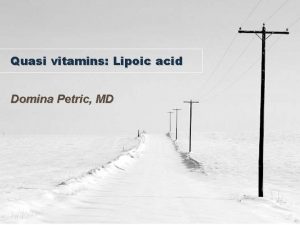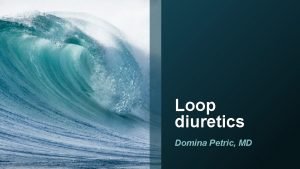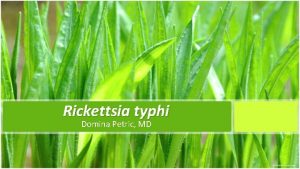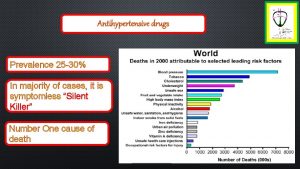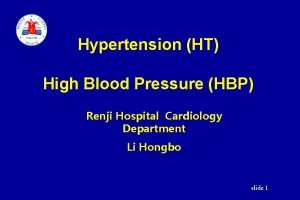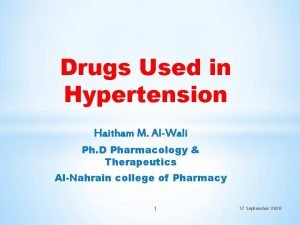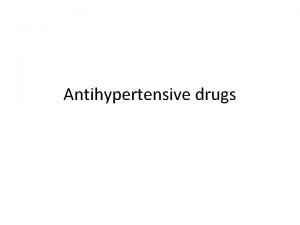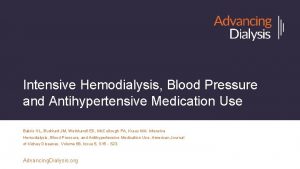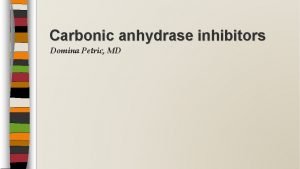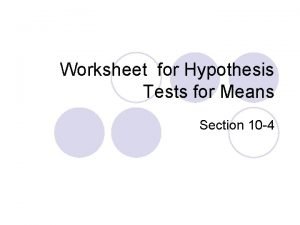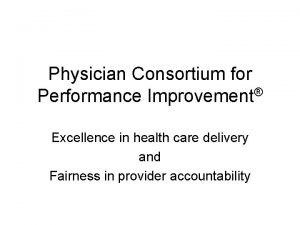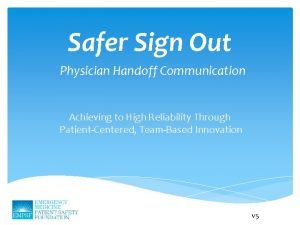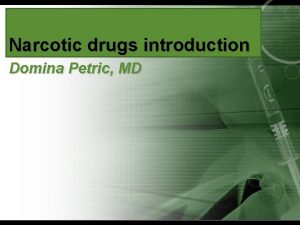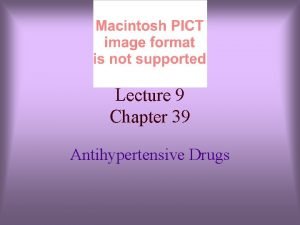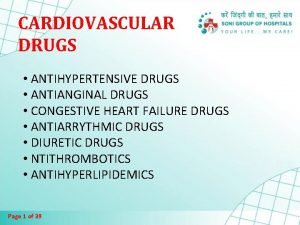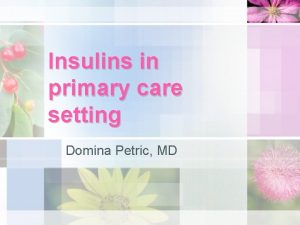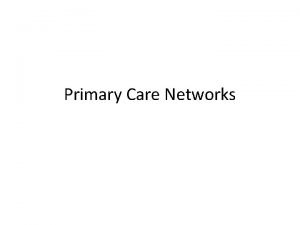Antihypertensive drugs for primary care physician DOMINA PETRIC



































- Slides: 35

Antihypertensive drugs for primary care physician DOMINA PETRIC, MD

1. ) Centrally acting antiadrenergic agents Imidazole receptors selective agonists: • moxonidinum • guanfacine (for ADHD)

Moxonidinum 0, 2 mg or 0, 4 mg tbl. ▪ For treatment of arterial hypertension. ▪ Start dose is 0, 2 mg per os a day. ▪ Maximum dose is 0, 6 mg per os a day divided in two doses. ▪ It can be taken with or without food. ▪ Contraindications are hypersensitivity, sick sinus syndrome, bradycardia (<50 bmp), AV block of II. and III. degree, heart insufficiency. ▪ It is not recommended to use it with tricyclic antidepressants and benzodiazepines. It is not recommended during pregnancy and lactation.

2. ) Peripherally acting antiadrenergic agents Alfa adrenergic receptors blocators: • doxazosinum • urapidilum

Doxazosinum 2 mg or 4 mg tbl. ▪ Indicated for arterial hypertension as monotherapy or in combination with tiazide diuretics, beta-blockers, calcium antagonists or ACE-i. ▪ It is also indicated for treatment of symptoms in benign prostatic hyperplasia. ▪ Start dose for arterial hypertension treatment is 1 mg. ▪ Maintenance dose is 2 -4 mg per os a day. ▪ Maximum daily dose is 16 mg. ▪ Contraindicated in hypotension and lactation.

Urapidilum Ebrantil 25 mg/50 mg ampulla Ebrantil 60 mg/90 mg tbl. ▪ for iv. application ▪ for treatment of arterial hypertension in adults ▪ hypertensive crisis ▪ refractory hypertension ▪ 30 mg per os twice a day for slowly lowering blood pressure ▪ 10 -50 mg iv. slowly ▪ 60 mg per os twice a day for more rapidly lowering RR ▪ arterial blood pressure monitoring is obligatory ▪ 60 -180 mg per os a day is maintenance dose

Urapidilum ▪ Contraindicated in pregnancy and lactation. ▪ Not recommended (caution is mandatory) for children and patients with heart, kidney or liver failure. ▪ Caution also with older patients and patients taking cimetidine.

DIURETICS 3. )

A) Low threshold diuretics, sulphonamides chlortalidonum indapamidum

Chlortalidonum (Hygroton 25 mg tbl. ) Indications are: ▪ arterial hypertension (esential, nephrogenic, systolic) ▪ chronic heart failure (NYHA II or III) ▪ ascites (liver cyrosis in stable patients) ▪ oedemas in nephrotic sydrome ▪ diabetes insipidus

Chlortalidonum (Hygroton 25 mg tbl. ) ▪ For arterial hypertension daily dose is 25 mg per os. ▪ Dose can be increased up to 50 mg per os a day. ▪ For heart failure dose is 25 -50 mg per os a day, but the dose can be increased up to 100 -200 mg per os a day. ▪ For diabetes insipidus start dose is 100 mg twice a day and then maintenance dose should be 50 mg a day. ▪ Contraindications are hypersensitivity, anuria, severe kidney failure (Cl. Cr <30 m. L/min), hypokalemia, hyponatremia, hypercalcemia, gout, hypertension during pregnancy.

Indapamidum (1, 5 mg tbl. ) ▪ Indicated for treatment of esential hypertension in adults. ▪ Dose is 1, 5 mg per os a day taken with glass of water in the morning. ▪ Contraindications are hypersensitivity, severe kidney failure, hepatic encephalopathy or severe liver damage, hypokalemia.

B) High treshold diuretics, sulphonamides torasemidum furosemidum

Furosemidum (40 mg tbl. , 500 mg tbl. , 40 mg/4 m. L ampulla for iv. application) ▪ Indicated for treatment of oedemas caused with heart or liver failure, oedemas in kidney diseases and arterial hypertension. ▪ Start dose is usually 40 mg and can be increased on 80 mg or even on 160 mg per os a day depending on the severity of the heart/liver/kidney failure. ▪ Diuresis (with furosemid) should not be more than 1 kg a day. ▪ High treshold diuretics better act when the daily dose is divided into two or three doses taken every 12 hours (or 8 hours if three doses, or 6 hours if four doses needed). ▪ For arterial hypertension dose is 40 mg a day.

Furosemidum ▪ Tablet should be taken on the empty stomach with lots of water. ▪ Contraindications are hypersensitivity, kidney insufficiency with anuria not responding on this medication, hepatic coma, severe hypokalemia or hyponatremia, hypovolemia or dehydration, during lactation.

Furosemidum 500 mg tbl. (Edemid forte) ▪ prevention of acute kidney insufficiency in patients with GF<20 m. L/min ▪ chronic kidney insufficiency before dialysis ▪ patent with fluid retention and very high blood pressure ▪ nephrotic syndrome (together with albumins infusion) ▪ resistent congestive heart failure Dose varies from 250 mg a day up to 2000 mg per os a day!

C) Potassium sparing diuretics, aldosterone antagonists spironolactonum eplerenonum

Spironolactonum 25 mg, 50 mg and 100 mg tbl. ▪ Indications are primary hyperaldosteronism, oedemas and ascites in conditions with secondary hyperaldosteronism. ▪ Dose is 50 -100 mg per os a day. ▪ Contraindications are anuria, acute kidney failure, hyperkalemia, hyponatremia, pregnancy and lactation.

Eplerenonum 25 mg and 50 mg tbl. Indication: chronic heart failure (LVEF≤ 40 %) for cardiovascular mortality and morbidity reduction. Maximum dose is 50 mg per os a day.

Beta adrenergic receptors blockers 4. )

A) Non-selective beta adrenergic blocators sotalolum propranololum

Propranololum 40 mg tbl. ▪ after acute myocardial infarction ▪ prophylaxis of stenocardic pain in patients with chronic stable angina pectoris ▪ arterial hypertension (alone or in combination, usually with tiazide diuretics) ▪ prevention of bleeding in portal hypertension ▪ pheochromocytoma ▪ esential tremor ▪ migraine

Propranololum 40 mg tbl. ▪ For arterial hypertension start dose is 80 mg per os twice a day. ▪ Overall daily dose can vary from 160 mg up to 320 mg. ▪ Contraindications are hypersensitivity, bronchial spasm (asthma, COPD), severe sinus bradycardia (heart rate <50 bmp), Prinzmetal´s angina, cardiogenic shock, right heart failure caused with pulmonary hypertension, severe heart failure, severe hypotension, risk of hypoglicemia. . .

B) Selective beta adrenergic blockers ▪ atenololum ▪ metoprololum ▪ bisoprololum ▪ esmololum ▪ nebivololum

Bisoprololum 2, 5 mg, 10 mg tbl. ▪ Treatment of arterial hypertension, angina pectoris, stable chronic heart failure with left ventricular systolic dysfunction. ▪ Start dose for arterial hypertension is 5 mg per os a day. ▪ Maintenance dose is 10 mg a day, maximum dose is 20 mg a day. Dose in stable chronic heart failure should be titrated: ▪ 1, 25 mg a day for a week ▪ 2, 5 mg a day for a week ▪ 3, 75 mg a day for a week ▪ 5 mg a day during next four weeks ▪ 7, 5 mg a day during next four weeks ▪ 10 mg a day is maintenance dose

Contraindications: ▪ acute heart failure ▪ cardiogenic shock ▪ AV block of II. and III. degree without pacemaker ▪ sick sinus syndrome ▪ symptomatic bradycardia, symptomatic hypotension ▪ severe bronchial asthma or COPD ▪ metabolic acidosis All beta adrenergic blockers should be taken carefully if patient is diabetic!

Calcium inhibitors V. )

Dihydropyridine derivatives ▪ amplodipinum ▪ lercanidipinum ▪ nifedipinum ▪ lacidipinum ▪ felodipinum

Lercanidipinum 10 mg or 20 mg tbl. ▪ Indication is mild to moderate esential arterial hypertension. ▪ Daily dose is 10 mg per os 15 minutes before meal with glass of water. ▪ Dose can be increased up to 20 mg. ▪ Lercanidipinum causes less peripheral oedemas than other dihydropyridine derivatives.

Renin angiotensin system agents VI. )

A) ACE-inhibitors ▪ quinaprilum ▪ lisinoprilum ▪ ramiprilum ▪ perindoprilum ▪ cilazaprilum ▪ trandolaprilum ▪. . .

Ramiprilum 1, 25 mg, 2, 5 mg, 10 mg tbl. treatment of arterial hypertension reduction of cardiovascular morbidity and mortality in patients with coronary artery disease, diabetes. . . treatment of glomerular diabetic nephropathy

Contraindications: ▪ hypersensitivity ▪ angioedema in family anamnesis ▪ bilateral renal artery stenosis ▪ second and third trimester of pregnancy ▪ severe hypotension ▪ haemodinamic instability

B) Angiotensin II antagonists ▪ irbesartan ▪ candesartanum ▪ losartanum ▪ valsartanum ▪ azilsartan medoximil ▪. . .

Literature: Mediately HALMED
 Domina petric
Domina petric Domina petric
Domina petric Domina severe
Domina severe Domina petric
Domina petric Domina petric
Domina petric Domina petric
Domina petric Domina petric
Domina petric Antihypertensive drugs classification
Antihypertensive drugs classification Antihypertensive drugs classification
Antihypertensive drugs classification Hypertension drugs
Hypertension drugs Classification of hypertension
Classification of hypertension Classification of antihypertensive drugs with examples
Classification of antihypertensive drugs with examples Wellstar physicians
Wellstar physicians Primary secondary tertiary care definition
Primary secondary tertiary care definition Antihypertensives classification
Antihypertensives classification Antihypertensive
Antihypertensive Jure petric
Jure petric Lucija petric
Lucija petric As 8 atitudes vencedoras
As 8 atitudes vencedoras Quimestres
Quimestres Cada miembro se compromete a aportar lo mejor de si mismo
Cada miembro se compromete a aportar lo mejor de si mismo Domina severe
Domina severe Türkische domina
Türkische domina Domina epistulam
Domina epistulam A physician claims that joggers maximum volume
A physician claims that joggers maximum volume Physician reentry programs
Physician reentry programs Physician consortium for performance improvement
Physician consortium for performance improvement Physician time study
Physician time study Physician segmentation and targeting
Physician segmentation and targeting Physician competency reference set
Physician competency reference set Coalition for physician enhancement
Coalition for physician enhancement Jeannie watkins
Jeannie watkins Physician sign out
Physician sign out Elisha goodman midnight prayer bullets
Elisha goodman midnight prayer bullets Colorado physicians health program
Colorado physicians health program Physician burnout retreat
Physician burnout retreat
